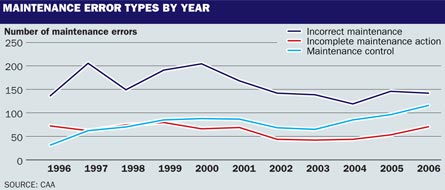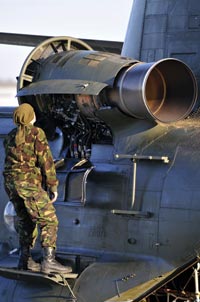The art of managing human factors in aircraft maintenance has been developing well over the past 20 years or so, but it still has a long way to go to reach maturity. That was the consensus at the UK Royal Aeronautical Society's recent conference on the subject.
Human factors and maintenance error management (HF-MEM) programmes have been in place at quality aircraft maintenance organisations for some time, and their introduction preceded by many years the relatively recently developed concept of all-embracing safety management systems (SMS).
Keven Baines, managing director of aviation consultancy Baines Simmons, says HF-MEM is an essential component of an SMS, and just as early attempts at HF-MEM did not work well, neither will early attempts at SMS as the same mistakes are being made.
EARLY DAYS
|
|---|
Industry failed, in the early days, to implement HF-MEM in the way it should have been introduced. That is, as a "top-down driven system in which the accountable manager is responsible for making it work".
The latter definition is a UK Civil Aviation Authority recipe for a successful SMS. Meanwhile, says Baines, SMS is being created by the framing of regulations, purely to ensure compliance, and this is not the way to win the kind of management buy-in that would make it top-down driven and therefore effective.
Speaking at the RAeS, Baines said: "Regulators tend to focus on compliance [for SMS] rather than effective implementation."
Andy Ebdon, head of Typhoon Support at Selex Galileo and chairman of the human factors group-engineering (HFG:E) at the RAeS, agrees with Baines: "Neither regulators nor operators are looking at the intent of the regulation. Implementation has been very training-centric [rather than performance-centric], and focuses on cost and achieving compliance."
There is no strategic approach, he adds, only tactical. Baines says that the European Aviation Safety Agency, in particular, shows no interest in SMS effectiveness, only in measuring compliance.
HF-MEM did not work brilliantly from the beginning because of the management tendency to see it as a compliance exercise rather than buying into the spirit of it.
Getting management buy-in by proving that investment in HF-MEM would produce a good return might have worked if it were possible, but proof has always been elusive as the data to provide it is just not collected by individual aircraft maintenance organisations, let alone across the industry as a whole.
Ebdon says that being able to prove the financial benefits of HF-MEM will be difficult or impossible until there is a standardised reporting system that acknowledges human factors. No-one seems to record maintenance error as a cost, as if it were an inevitable component of doing business.
Ebdon says: "Current databases are not typically designed to enable HF analysis, yet the human is still the largest remaining risk." He adds: "We continue individually and collectively to swat mosquitoes rather than to drain the swamp."
Baines points out: "Proving a negative requires empirical evidence of past spend on output failure in order to measure the improvement." He adds: "Even in a mature MEMS, financially based KPIs [key performance indicators] are rare."
Some things can be measured, and have been, he says: "We now know which ATA Chapters [an internationally accepted Air Transport Association system for categorising maintenance functions] deliver the most harm/loss, but we don't intervene very differently".
Under the ATA classification, the greatest number of maintenance errors involve "equipment and furnishings", followed by "combined powerplants", then landing gear, and finally flight controls, with all other categories featuring much lower numbers.
By far the largest number of errors occur at the installation stage (44%), whatever the component. Trailing some distance behind installation errors are mistakes in which approved data was not followed (14%), servicing errors (12%), and errors from poor inspection standards (12%).
Ebdon cited figures from "a major maintenance organisation" that costed its average error at £6,200 ($9,550) per event, with a total error cost over seven recent months of £80,600. But that was the cost only of rectifying errors, most of which may have been corrected before the aircraft was returned to the operator.

ERROR AND FLIGHT SAFETY
It is accepted that regulators, in drawing up their rules about maintenance practice, must inevitably focus on flight safety risk, whereas businesses have a wider range of undesirable outcomes to consider that may never get as far as the flightline.
Baines says there is a problem with businesses focusing HF-MEM solely on preventing flight safety hazards, or measuring success only in flight safety hazards prevented. He points out that "only some" of an aircraft maintenance organisation's errors escape its defences to present a flight safety hazard. "The vast majority represent internal losses or harm."
Despite all these weaknesses in HF-MEM programmes, Ebdon says they are producing encouraging results. He cites the experience of a major aircraft manufacturer's own aircraft maintenance organisation that had put all its crews through HF-MEMS training.
It was able to report that three months after training, a massive majority of employees responded positively to a questionnaire on how they feel about their working effectiveness. The positive response extended to every issue surveyed, from improved knowledge and effectiveness to improved use of technical data.
Another large aircraft maintenance organisation conducted a survey two years after introducing HF-MEM and got similar feedback, with 89% saying they apply the newly learned HF principles in their day-to-day work, and 71% saying they would be more likely to raise a MEM report than before.
Good early results from a newly implemented HF-MEM programme have not been restricted to the civil aircraft maintenance arena. HF-MEM was implemented in the UK Royal Air Force in 2009. The RAF did not want to sacrifice the military "can do" spirit in maintenance any more than on the frontline in Afghanistan, so it called the programme "can do safely".
Air Vice-Marshal Nick Kurth's report of performance for June-December 2009 revealed that the introduction of a trusted "just culture" had improved maintenance error reporting dramatically, with 15% of the reports submitted by the individuals that had made the errors or experienced a near-miss.
Meanwhile the quality of error investigations has improved, with reports addressing performance-influencing factors, not just the technical nature of the error. Kurth also reported that there was a clear buy-in at management level, and revealed that there has been "significant positive feedback from the frontline indicating a strong desire for more".
But the most encouraging result was improvement in the end product. Kurth reported that there was definite evidence of physical improvement in the condition of aircraft, with a dramatic fall in the number of aircraft faults found during condition audits of aircraft types across the fleet. Comparing 2010 figures with the same period in 2008, the number of faults had been reduced by at least two-thirds, but in many cases much more.
But providing advice for those embarking on launching an HF-MEM system, Kurth warns managers not to underestimate the administrative resources needed to cope with the increased reporting and investigating.
He also warns that if, when investigators make recommendations, the organisation then fails to allocate resources to implement them, the credibility of the whole system can be undermined. He admits that, this early in the RAF's experience, there is still "a need to unlock the information in the vast quantity of data from the bottom of the iceberg".
Back in the civilian world, Baines revealed the results of an extensive survey of companies in the process of establishing an SMS. Companies said their main problem was getting management buy-in at all levels. Some of this is because of the perception that SMS was something to be compliant with, rather than something that delivers benefit, because SMS has been "regulated into existence".
Its products have been "features rather than effectivenessWe need a regulator that can focus on effectiveness". With a hint of sarcasm, Baines posed the question: "How many HF-MEMS accountable managers want their systems because they are good for business?" He also observed that "neither the approved [HF-MEMS] organisation nor the regulator has a clear view of what 'good' looks like".
But despite reporting on the present difficulties associated with HF-MEM and SMS, Baines sees this time as a golden opportunity to sell SMS on a "WIIFM" (what's in it for me) basis - as a wide-ranging system for managing business risks, one of which is flight safety.
Ebdon summarises the fundamental components of a successful HF-MEM system:
- Senior management buy-in.
- A real "just culture".
- Effective error investigation.
- Rapid feedback on lessons learned.
- Bottom-up information listened to and acted upon.
DESIGN FOR MAINTENANCE
Given the high preponderance of errors at installation, the issue of aircraft design for maintainability is clearly important. Ebdon says the RAeS HFG:E is studying the subject. Questions being asked include: "Are designers competent to design for safe maintenance? Does maintenance feedback reach the designers?"
Ebdon asks: "Do designers understand or consider the realities of the aircraft maintenance environment? Is there adequate verification/validation of manufacturer's recommended procedures?" HFG:E, he says, is seeking examples of best practice, but he adds that wider consultation with the industry is needed to define such practice with more confidence.
All presenters agreed that operating a good HF-MEM or SMS programme will take an organisation "beyond compliance", so Ebdon lists the benefits of going that extra mile:
- On-time delivery.
- Better culture and behaviour.
- More efficient use of resources.
- Increased customer satisfaction/confidence.
- Reduced losses.
- Proven return on investment.
- Improved operational performance.
- Record of due diligence in an event.
- A reduced number of surprises.
As a result, says Ebdon, what he calls "pathological operators" will become progressively more conspicuous by comparison with smart players. His definition of a "pathological" operator culture is one in which corporate thinking goes something like: "Who cares about standards as long as we're not caught?"
The RAF seeks to foster a "can do" spirit in maintenance as well as on the frontline
Source: Flight International














